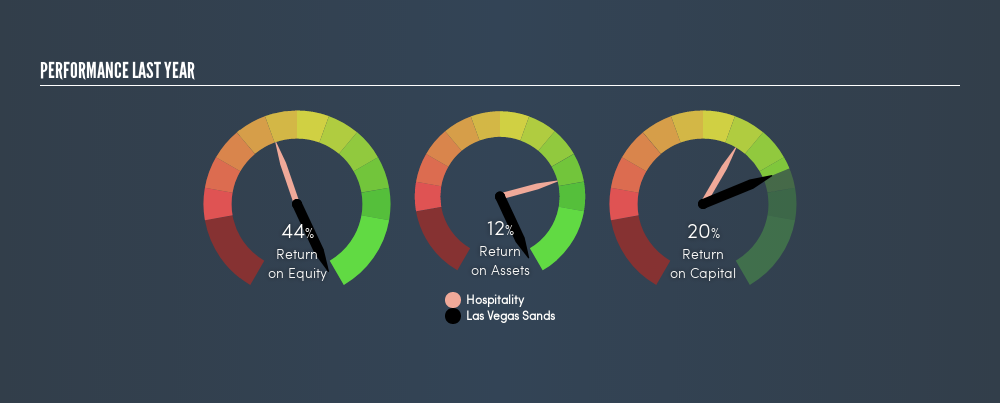
Today we'll evaluate Las Vegas Sands Corp. (NYSE:LVS) to determine whether it could have potential as an investment idea. To be precise, we'll consider its Return On Capital Employed (ROCE), as that will inform our view of the quality of the business.
First up, we'll look at what ROCE is and how we calculate it. Then we'll compare its ROCE to similar companies. Finally, we'll look at how its current liabilities affect its ROCE.
Return On Capital Employed (ROCE): What is it?
ROCE measures the 'return' (pre-tax profit) a company generates from capital employed in its business. Generally speaking a higher ROCE is better. In brief, it is a useful tool, but it is not without drawbacks. Renowned investment researcher Michael Mauboussin has suggested that a high ROCE can indicate that 'one dollar invested in the company generates value of more than one dollar'.
So, How Do We Calculate ROCE?
The formula for calculating the return on capital employed is:
Return on Capital Employed = Earnings Before Interest and Tax (EBIT) ÷ (Total Assets - Current Liabilities)
Or for Las Vegas Sands:
0.20 = US$3.9b ÷ (US$23b - US$3.2b) (Based on the trailing twelve months to December 2018.)
Therefore, Las Vegas Sands has an ROCE of 20%.
Check out our latest analysis for Las Vegas Sands
Is Las Vegas Sands's ROCE Good?
ROCE is commonly used for comparing the performance of similar businesses. In our analysis, Las Vegas Sands's ROCE is meaningfully higher than the 10% average in the Hospitality industry. We consider this a positive sign, because it suggests it uses capital more efficiently than similar companies. Independently of how Las Vegas Sands compares to its industry, its ROCE in absolute terms appears decent, and the company may be worthy of closer investigation.
In our analysis, Las Vegas Sands's ROCE appears to be 20%, compared to 3 years ago, when its ROCE was 16%. This makes us think about whether the company has been reinvesting shrewdly.

Remember that this metric is backwards looking - it shows what has happened in the past, and does not accurately predict the future. ROCE can be deceptive for cyclical businesses, as returns can look incredible in boom times, and terribly low in downturns. ROCE is, after all, simply a snap shot of a single year. Since the future is so important for investors, you should check out our freereport on analyst forecasts for Las Vegas Sands.
What Are Current Liabilities, And How Do They Affect Las Vegas Sands's ROCE?
Current liabilities include invoices, such as supplier payments, short-term debt, or a tax bill, that need to be paid within 12 months. The ROCE equation subtracts current liabilities from capital employed, so a company with a lot of current liabilities appears to have less capital employed, and a higher ROCE than otherwise. To check the impact of this, we calculate if a company has high current liabilities relative to its total assets.
Las Vegas Sands has total assets of US$23b and current liabilities of US$3.2b. As a result, its current liabilities are equal to approximately 14% of its total assets. Low current liabilities are not boosting the ROCE too much.
What We Can Learn From Las Vegas Sands's ROCE
Overall, Las Vegas Sands has a decent ROCE and could be worthy of further research. But note: Las Vegas Sands may not be the best stock to buy. So take a peek at this freelist of interesting companies with strong recent earnings growth (and a P/E ratio below 20).
If you like to buy stocks alongside management, then you might just love this freelist of companies. (Hint: insiders have been buying them).
We aim to bring you long-term focused research analysis driven by fundamental data. Note that our analysis may not factor in the latest price-sensitive company announcements or qualitative material.
If you spot an error that warrants correction, please contact the editor at editorial-team@simplywallst.com. This article by Simply Wall St is general in nature. It does not constitute a recommendation to buy or sell any stock, and does not take account of your objectives, or your financial situation. Simply Wall St has no position in the stocks mentioned. Thank you for reading.
About NYSE:LVS
Las Vegas Sands
Owns, develops, and operates integrated resorts in Macao and Singapore.
Good value with moderate growth potential.
Similar Companies
Market Insights
Community Narratives



